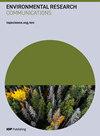Vegetation reduces cooling demand in low-income neighborhoods on hot days in Chicago
IF 2.5
4区 环境科学与生态学
Q3 ENVIRONMENTAL SCIENCES
引用次数: 0
Abstract
Cooling energy demand is sensitive to urban form and socioeconomic characteristics of cities. Climate change will impact how these characteristics influence cooling demand. We use random forest machine learning methods to analyze the sensitivity of cooling demand in Chicago, IL, to weather, vegetation, building type, socioeconomic, and control variables by dividing census tracts of the city into four groups: below-Q1 income--hot days; above-Q1 income--hot days; below-Q1 income--regular days; and above-Q1 income--regular days. Below-Q1 census tracts experienced an increase in cooling demand on hot days while above-Q1 census tracts did not see an increase in demand. Weather and control variables unsurprisingly had the most influence on cooling demand. Among the variables of interest, vegetation was associated with reduced cooling demand for below-Q1 income on hot days and increased cooling demand for below-Q1 income on regular days. In above-Q1 income census tracts building type was the most closely associated non-weather or control variable with cooling demand. The sensitivity of cooling demand for below-Q1 income census tracts to vegetation on hot days suggests vegetation could become more important for keeping cities cool for low-income populations as global temperatures increase. This result further highlights the importance of considering environmental justice in urban design.植被减少了芝加哥低收入社区炎热天的降温需求
制冷能源需求对城市形态和社会经济特征非常敏感。气候变化将影响这些特征对制冷需求的影响。我们使用随机森林机器学习方法分析了伊利诺伊州芝加哥市的制冷需求对天气、植被、建筑类型、社会经济和控制变量的敏感性,将该市的人口普查区分为四组:低于 Q1 收入的炎热天;高于 Q1 收入的炎热天;低于 Q1 收入的正常天;高于 Q1 收入的正常天。收入低于第一季度的人口普查区在高温天的制冷需求增加,而收入高于第一季度的人口普查区的需求没有增加。天气和控制变量对制冷需求的影响最大,这一点不足为奇。在相关变量中,植被与 Q1 收入以下人口普查区炎热天降温需求减少和 Q1 收入以下人口普查区普通天降温需求增加有关。在 Q1 收入以上的人口普查区,建筑类型是与冷却需求关系最密切的非天气或控制变量。Q1 收入以下人口普查区在热天的降温需求对植被的敏感性表明,随着全球气温的升高,植被对低收入人群保持城市凉爽可能变得更加重要。这一结果进一步强调了在城市设计中考虑环境正义的重要性。
本文章由计算机程序翻译,如有差异,请以英文原文为准。
求助全文
约1分钟内获得全文
求助全文
文献相关原料
| 公司名称 | 产品信息 | 采购帮参考价格 |
|---|

 求助内容:
求助内容: 应助结果提醒方式:
应助结果提醒方式:


